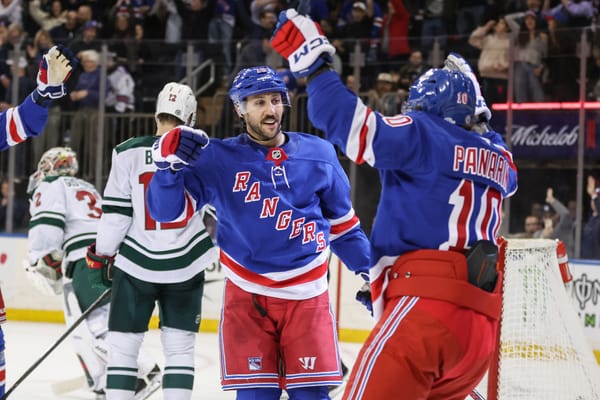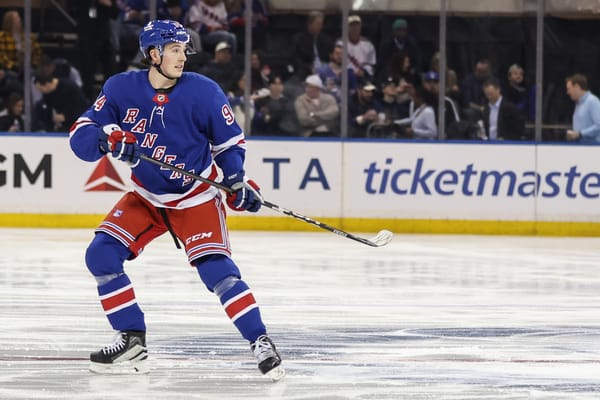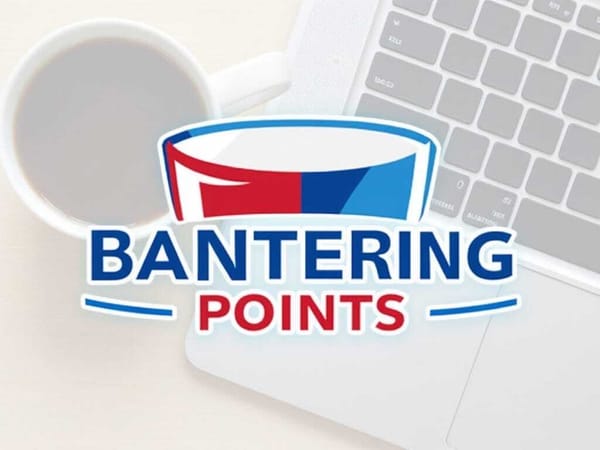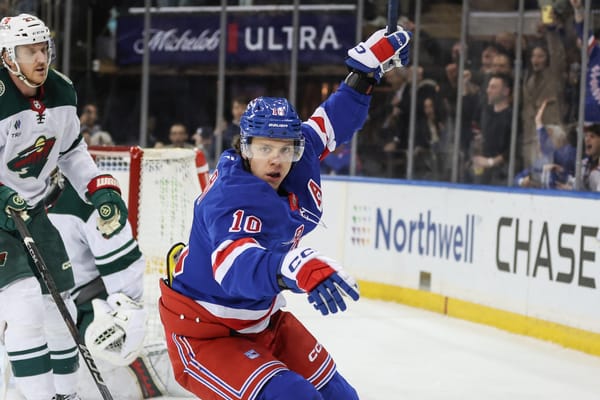Blueshirt Banter 2018 Prospect Rankings Mailbag
Following the publishing of our 2018 New York Rangers Prospect Rankings, many of you had questions and comments. Here is my attempt at milking this content as much as I can because August is a void full of despair addressing some of the your thoughts.
Maybe present your list in terms of tiers? @Drews_Way and co. did so with 2018 NHL Draft prospects, since at a certain point numerical rankings can get arbitrary/subjective.
— HockeyStatMiner (@HockeyStatMiner) August 10, 2018
If you're looking for more work that is 😋
Something like this.
Grouping players is important. Individual rankings are fun for philosophical reasons and important in case of trades. Should the Rangers need to include a Tier Three prospect in a trade, then suddenly determining which ones you like more is suddenly important. Big picture, though, I don’t think there’s a particularly meaningful difference in value between Hajek and Pionk, and in fact I changed my mind multiple times regarding how to rank the two.
It can also get a bit weird. Vinni Lettieri is a 23-year-old as close to crossing the line to NHL regular as one can be, but with 4th-line potential. Calle Sjalin is still 18 and lightyears away from any meaningful NHL ability, but also has top-four upside. It’s hard to really accept the idea that these two are equals as prospects. That’s why I offer tiering as supplementary commentary rather than as a forefront, integral part of my analysis. In some cases, it’s vital, but in others it’s extremely limiting.
Who is a dark horse to make the team out of camp? I’d say maybe Day or Lindgren but I think Day needs AHL time and Lindgren would be probs be beaten out by Hajek
— Kyle Brandeau (@Shestyorkin2020) August 13, 2018
Let’s first run down the list of prospects who will be serious contenders for a spot on the Rangers out of training camp.
Of course, both Filip Chytil and Lias Andersson are on the list. I would guess one of them makes the team.
On defense, I don’t think there will be any surprises. I don’t really think Hajek or Lindgren are ready, and even if they are getting them NHL experience isn’t a priority. The Rangers have a much shorter timeline to figure out what they have in Anthony DeAngelo, Neal Pionk, and John Gilmour.
On the wing, Michael Lindqvist and Ville Meskanen will be heavily in the mix. Perhaps Ty Ronning is a dark horse candidate, but I doubt it to be honest.
My darkhorse candidate is Gabriel Fontaine. The Rangers have no obvious choice for fourth-line center right now. Sticking on of Andersson or Chytil in that limited role would not be great for their development. The same holds true for Brett Howden. Ryan Spooner or Vlad Namestnikov could do the job, but they are overqualified. Not the best move if the Rangers want to build trade value.
That leaves Boo Nieves and Peter Holland. Either could probably plug that hole for a season. That would likely spell disaster for a team with aspirations of winning. For the Rangers’ purposes, though, they could probably get through a season with one or both.
And so maybe Gabriel Fontaine can win that spot. He has NHL size, wins faceoffs, and defends well. He works hard every shift and is not a total blackhole offensively. By opening night he’ll be halfway to 22 years old, so it’s not as if there is much development left for him to do at a lower level, and depending on how the Rangers’ roster shakes out he might end up getting bottom-six minutes in Hartford regardless. The onus would be on him to actively stand out in the preseason, but if he does I don’t see why he shouldn’t be on the NHL roster.
When evaluating prospects, what role does position play among forwards? I think historically we have heard that centers are tasked with playing more of a defensive role, and therefore they tend to be valued more than winger.
— Tom Urtz Jr. 🥅📊📉🎰 (@TomUrtzJr) August 10, 2018
This is a common question, and this year it more specifically pertains to Kravtsov versus Chytil. In their case, Chytil’s superior ranking has more to do with track record. Kravtsov was a good, but not, great prospect up until he exploded during the KHL playoffs. Chytil has made his mark in international tournaments, during the NHL preseason, and at the AHL level.
All things being equal, position does matter. Centers have more responsibility and thus tend to impact the game more than wingers. Furthermore, there’s the topic of value. Centers are worth their weight in gold on the trade market and in free agency. That certainly played a part in Brett Howden’s ranking. Brian Boyle returned a second-round pick as a rental two years ago, while Nick Bonino and Jay Beagle got paid absurd money as free agents in recent offseasons. Those are just a few examples of many. Meanwhile, you could hibernate through the first three days of free agency and wake up to find a handful of capable wingers still available for cheap.
But teams can sometimes go way too far in the other direction. Montreal were so desperate for a top-six center that they talked themselves into Jesperi Kotkaniemi being a top-three prospect in the 2018 Draft when he clearly was not. And again, I mentioned those contracts Nick Bonino and Jay Beagle received. So while position is considered, it can’t be a significant driver of evaluation.
Thanks to Twitter user @bishop35 for this question. Generally speaking, Rykov and Hajek are indeed similar prospects. They are both good skaters with good size. They defend well in the defensive zone and play the role of “steady” defenseman who might match up well with a more glamorous partner.
I rate Rykov better because of a combination of upside and track record. The difference between the two isn’t dramatic, but it’s still distinct. Rykov has made his mark in the second-best league in the world, playing against grown men. Hajek isn’t exactly raw, as he was trusted to play in the Czech league as a 16-year-old. But whereas I think Rykov could step into the NHL right now, I think Hajek will have a learning curve before he might be NHL-ready.
I also think Rykov has more upside. He’s not an offensive dynamo, but he is definitely better on the puck than Hajek is. Rykov a better mover of the puck through the defensive and neutral zones. He is also more useful in the offensive zone. That’s the one area where he really distances himself from Hajek. Rykov is very good at getting shots through traffic. While I don’t think he will rack up a bunch of goals, I think he will keeps plays alive and accumulate a fair share of assists from deflections or rebounds from his shots.
Looking through the system so thoroughly, what is an area of weakness that the Rangers still need to address? Is there still a large gap between the Rangers prospect pool and some of the higher tier systems in the league?
— Reed Logan (@99Reedballoons) August 10, 2018
I would rank the Rangers’ prospect pool somewhere between 8-12 among the 31 NHL teams. As I discussed with Dimitri Filipovic of Sportsnet, that shows what an incredible job the Rangers have done to overhaul their organization in such a short amount of time. Just 18 months ago, the Rangers would have ranked in the bottom-three of the NHL, and that’s being generous.
Among players in my prospect rankings, Igor Shestyorkin and Adam Huska are the only prospect in the top-15 who were in the organization prior to March of 2017. That’s a hell of a quick turnaround.
Still, the Rangers have a lot of work to do. I’ve harped on this ad nauseam, but I still don’t see the obvious foundational players for a Stanley Cup winner. The Vancouver Canucks and Buffalo Sabres have done practically everything wrong in the last five years. For all of their issues, though, they do have that foundation. It’s quite easy to see Elias Pettersson, Quinn Hughes, and Brock Boeser being the three-best players on a Stanley Cup winner in five years. For Buffalo, Jack Eichel and Rasmus Dahlin are generational talents, with Sam Reinhart and Case Mittlestadt offering strong support.
It’s way too soon to earnestly throw Vitaly Kravtsov into that category, while Filip Chytil is straddling the line. He’s a maybe, and even then he’s just one player. One that certainly won’t measure up to the generational talents.
So the Rangers still have a lot of work to do yet. They’ll never admit it publicly, but the Rangers would sure benefit from a top-three selection in the 2019 Draft. Because of who the Rangers are, they do have the luxury of eventually adding one superstar via free agency (like John Tavares to Toronto) or a bargain-bin trade (Rick Nash to the Rangers). So they certainly have way more flexibility in building a team than, say, the Carolina Hurricanes do.
In terms of specific area of need, it’s wing. Kravtsov is a great prospect, but my next-ranked winger is Tim Gettinger all the way down at 15. They desperately need wingers with top-six upside.
“How can you rank Player X the way you did when The Consensus™ has him much higher/lower?”
This is a frequent remark. This year, it pertained particularly to Libor Hajek (11) and Ryan Lindgren (25), whereas public perception appears to be that these players are better than I give them credit for. I don’t mind defending my takes, and in fact I think it’s an absolute necessity. What can be irksome, however, is the implication that straying too far from entrenched groupthink is conceptually inappropriate.
I had some incredible history/social studies teachers in school. One concept that I will always thank them for impressing on me is that, in order to write a great persuasive essay, one needs to first research and understand the opposing argument. Either you will learn something new and modify - perhaps altogether reverse - your stance, or you’re going to specific arguments from the other side you will need to debunk in order to convince them of your stance.
I take all of that to heart when writing about hockey. I talk to scouts, data specialists, and so on regarding most players. But I go out of my way to engage in conversation regarding the players I feel most strongly about in search of opinions or context I am missing. Sometimes, I do change my feelings. On draft day, I thought Joey Keane’s ceiling was limited to third-pairing upside. After seeking out data and the opinions of others, I softened that stance. Other times, I stick to my guns and am able to tailor my writing towards addressing those arguments.
To paraphrase The Athletic’s Corey Pronman, any ranking of prospects with organic, researched opinions is going stray from the consensus. We see this at the NHL Draft every year. According to TSN’s Bob McKenzie, K’Andre Miller was 10th on one team’s draft list while 39th on another’s. If I were to ask 5 NHL GMs, 5 NHL players, 5 analytics experts, 5 hockey media members, and 5 fans to rank the ten-best NHLers, I would get 25 different answers. That’s for established, known entities. So to think that we can and should expect any kind of meaningful hive mind when predicting what a bunch of 18-21 year-old’s will look like in five years is foolish.
I have been right in the past. My best moment was probably expressing shock when Viktor Arvidsson went undrafted in 2013. I was also proven right when I questioned Pronman’s placing of Danny Kristo ahead of Oscar Lindberg and Jesper Fast. And by considering Sergey Zborovskiy a virtual non-prospect from the moment the Rangers drafted him.
On the other hand, I have also been very wrong. I consistently ranked Anthony Duclair higher than Pavel Buchnevich and thought he would be an established first-line forward by now. Pronman got that one right. And while the Yandle trade itself is a whole different discussion, the Rangers got it right and I got it wrong when analyzing Duclair’s future in the league. I thought Michael St. Croix was a much better prospect than he turned out to be. Looking back at past prospect rankings, I was a bit too reserved in my analysis of Shestyorkin. I thought Robert Thomas was more of a second-round talent in the 2017 draft, whereas the Blues drafted him 20th overall and now he’s one of the top prospects in hockey. I could go on-and-on.
History will be the judge. I’ll prove to be very right about some players and completely wrong on others. But for better or worse, this is the end-product of a year full of watching so many games it induced nausea at times, along with plenty of hours talking with various people in-the-know, analyzing data, reading the work of others, and so on.




